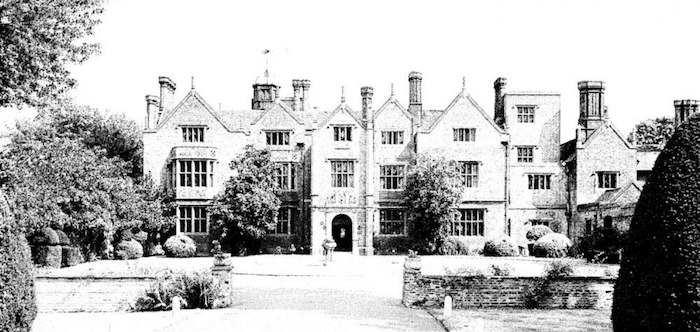
Close

Built: 1550
Great Fosters Hotel was built in 1550, and originally served as a stately home and royal hunting lodge. The hotel’s unique heritage can be seen in the mullioned windows, topiary mazes, Saxon moat, and sundial that Sir Francis Drake, the famous English explorer, gifted to the estate. Over the course of its 400-year history, the hotel has hosted a number of legendary guests, including Orson Welles and Charlie Chaplin.

Sir Hugh Warham– Born in England c1456- Died in England c1538
Marion Colles– Born 1460, Married 1476, Died 1500
Thomas Botwell – Died 1569 in England
Sir John Denham – 1559-1639
Sir John Thynne – Died 1608
Mary Watson – Wife of Sir Anthony Mayne
Sir Anthony Mayne – Husband of Mary Watson – Born 1572 and Died 1627
Sir John Doderidge – Judge- Born in England 1555 and Died 1685
Thomas and Mary Bennet– 1580-1621
Sir Robert Foster, Sergeant at Law – Born 1589 and Died in Glocester, England in 1663
Thomas Foster – Born 1617 and Died 1685
Edward Woodard
Sir Charles Orby – Died 1723
Richard Brown
Dr. George Feredrick Furnivall – Surgeon
Sir John Chapman
Colonel Halkett, Baron of the Kingdom of Hanover- Born 1822 and Died 1880
Harold Sutcliffe – Born in 1897 and Died in 1958
An exquisite relic of antiquity, Great Fosters boasts over four centuries of fascinating history. Located in the heart of Surrey, this estate has hosted an eclectic collection of tenants and visitors – from Henry VIII to Charlie Chaplin. Now a charming boutique hotel, this historic building and the land that surrounds it are replete with reminders of its rich history, including an original royal crest of Queen Elizabeth I that dates back to 1598 and a sundial rumoured to have been gifted to a tenant from Sir Francis Drake.
Throughout the Middle Ages, the original manor on the Fosters site was referred to as the Manor of Imworth, and the earliest reference to the site as ‘Fosters’ can be found in the court rolls of Thorpe in 1512. The original manor was enclosed by a Saxon moat, which – impressively – still surrounds the estate to this day. According to a survey conducted by King Edward VI, the first known owner of the property was the youngest brother of Archbishop Wareham, Hugh Warham, whose son built the current house when he took over the estate in 1555.
During the 16th and 17th centuries, Fosters changed hands a number of times as a result of financial issues and fierce family feuds and, fascinatingly, the exact inhabitants, purpose, and tenancy of the property remains somewhat inconclusive. One thing is certain, however – the house has enjoyed many royal connections. Whether or not the house was used as a royal residence is unknown, but it was certainly used as a hunting lodge by both Henry VIII and Elizabeth I, who is thought to have spent a lot of time on the estate as a child. There are also indications that Anne Boleyn had a link to the estate, as her personal crest and royal symbols can be seen in the intricate ceiling decoration of what is now the Tapestry Suite.
Fosters has also been host to a number of curious and historically significant incidents at the hands of its various tenants. For example, Sir Robert Foster, who inhabited Fosters during the time of the Civil War, woke up one morning and decided to leave his wife, five children, and twelve servants in order to fight for the king, In his absence, Parliamentary troops made their way into Fosters, plundered the house, and eventually forced his family to leave. More than a century later, Fosters was in the hands of Dr Furnivall, a founding member of the Royal College of Surgeons who harboured revolutionary ideas on the treatment of mental illness, and it is thought that the house served as lunatic asylum – perhaps even the very asylum that King George III was housed during his treatment for insanity.
With the 20th century came a time of great development under the Hon Gerald Samuel Montagu, who was instrumental in making the house what it is today. He commissioned architect W H Romaine-Walker who – although most famous for his work on the Tate Gallery – specialised in restoring country houses and parish churches. Romaine-Walker did a remarkable job designing a magnificent garden and restoring the building in a way that honours its heritage. An abundance of architectural details have been lovingly maintained, including walnut doors constructed from walnut trees grown within the grounds of the estate, Jacobean chimneypieces, and a carved mantle depicting the story of Adam and Eve in the Garden of Eden.
When Great Fosters first established itself as a hotel and opened its doors to the public, it quickly gained a reputation as an exclusive and fashionable place to be, which was proven by Queen Mary’s visit in 1931 and the subsequent invitation to hold the Ascot Ball. This sense of luxury and grandeur is still very much alive today, as guests are treated like royalty and encouraged to soak up the charm and beauty of an iconic estate.